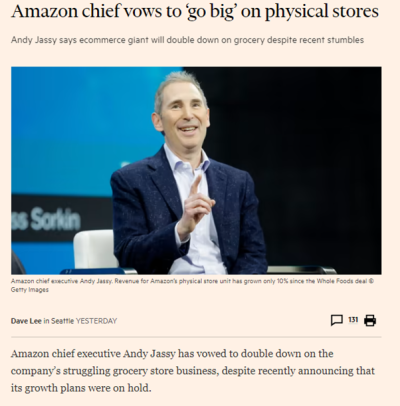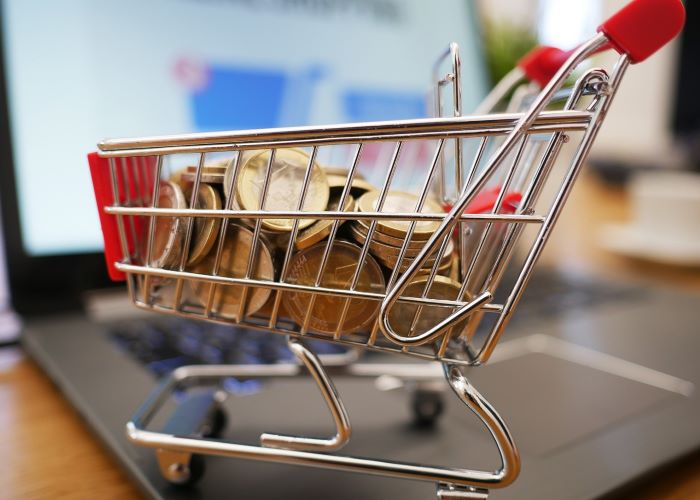If you would like to receive weekly updates like this, sign up here.
You do realize this is going to happen one day soon.
Negotiating your mortgage refinancing with Apple.
Searching for your next Alphabet home to live in via your Google mobile phone.
And of course, the gift that keeps on giving: checking your receipt for errors after your latest shop at “just-walk-out checkout-free” grocery store.
Even three years ago, to make such a statement would elicit bewilderment and mild amusement.
But not today.
Most people fully now expect everything above to become mainstream in the future.
Let’s focus on the last of those, the Amazon store.
Were you aware that Amazons biggest and most expensive purchase ever was a chain of grocery stores?
Even more importantly though, do you know what that and the 18.6-year Real Estate Cycle have in common?
At first even I didn’t twig this.
But today it’s now very clear what’s going on here.
Amazon is showing us the future today. Only it has nothing to do with groceries.
It’s a massive buy signal – but not for your weekly fruit and veg.
Read on to find out what this signal says.
What’s so ‘Fresh’ about bricks and mortar?
Let’s take a step back here.
We need to relook at Amazons’s huge decision to enter the grocery business back in 2018.
They spent over US$13 billion to buy Whole Foods, an American national grocery retailer.
At the time it sent shockwaves throughout the US retail industry.
Those involved in retail foresaw the biggest shakeup in the sector given Amazon’s known ability to harvest data and e-commerce to drive unique efficiencies.
The prevailing view was, whatever innovation Amazon brought to the humble weekly shopping trip for customers, other retailers would simply have to follow suit or, more likely, lose market share and wither away.
And for a while Amazon did indeed introduce some fascinating technology into the humble grocery shop experience.
Not by simply offering lower prices but embedding new checkout technology that basically replaced the traditional check-out guy/girl.
Cameras were installed that had AI algorithms written that would follow shoppers around the store. Well-hidden weights on stock shelfs monitored whenever an item was picked up.
Your shopping cart was a smart device tracking everything you placed inside it.
Finally, you could simply walk out with that same trolley without stopping.
By using palm scanning technology, you brought your items without the need for a wallet or mobile phone. Your receipt would be emailed to you later.
It was world-leading by some distance. The future has arrived.
Or had it?
In fact, technological progress met biological reality. Whatever momentum Amazon was gaining it quickly lost by the covid-led lockdowns which shut down the traditional grocery store.
For Amazon, though, things quickly reverted to its normal business.
They already enjoyed market share thanks to Amazon Prime’s online ordering service.
And with the world now having to go online to order anything, this part of the Amazon empire thrived.
Therefore, their Amazon Fresh venture was looking like a potential train wreck. Even after the economy reopened, the staff that previously worked in the grocery stores were gone.
Most weren’t interested in coming back. Ironically, most had become food delivery drivers.
This was the only way to deliver what Amazon Prime customers ordered online plus it was deemed a critical service and therefore not locked down during the pandemic.
To those watching from the sidelines, the winner and losers here were clear.
Online shopping was here to stay, the foot traffic into traditional grocery stores was about to disappear.
So, how do you explain this decision then?
Amazon’s great sleight of hand.
I guess every new CEO of a huge publicly listed company feels he or she needs to make an immediate splash with investors and shareholders.
But this article below really made me stop and think.

Source – FT
You can count me as one of those who thought hands down online shopping was where Amazon would double its efforts.
We were wrong. It seems that its actually grocery stores where they are going to make huge investments.
Sure, the Whole Foods buyout hasn’t proven to be the out of the ballpark home run Amazon had hoped for. For the reason explained above.
This time, though, it will be Amazon’s own take on retail grocery shopping.
It will roll out hundreds of purpose-built Amazon-Go and Amazon-Fresh stores in both the former Whole Foods locations and a whole host of newer inner-city locales.
Will this new initiative succeed? Some think not.
“They don’t really understand physical retail very well,” said Neil Saunders, a retail analyst, suggesting Amazon’s technology had not been enough to break US consumers’ habits of shopping at established players.
“They’ve got ‘just walk out’ technology, they’ve got smart carts. Great, really interesting. But how many customers say, ‘Hey, I’m going to shop somewhere because they’ve got a smart cart’? No one.
It’s at this point most folks research into this topic ends. They adopt a “wait and see” approach.
Not this writer!
There is far more going on here. This is where knowledge of the cycle is critical.
The timing of this announcement is not a coincidence.
The focus on physical stores rather than online delivery hubs? Deliberate.
People, this has nothing to do with groceries.
This is a real estate play.
Amazon is in the landlord business. Utilizing their large war chest of billions of dollars to secure debt on favorable terms.
Andy Jassy didn’t mention that did he?
Those technologies that Amazon will incorporate into these hundreds of new stores will be reported as trying to establish new norms for the average US retail shopper.
Recall the above quote from Neil Saunders.
“They’ve got ‘just walk out’ technology, they’ve got smart carts. Great, really interesting.
Neil has this totally wrong.
That same technology will yield benefits that over time manifest into the price of the land those same stores now reside on.
Providing long term earnings and benefits to Amazons shareholders that far exceed grocery sales.
Now, before I go all blue in the face (again!) let me spell it out simply.
It is time for these types of deals to be occurring.
From the way they aren’t reported, to the availability of cheap credit to fund them and positioning a huge real estate portfolio right in the middle of a global building boom.
Has anyone else pointed this out to you in the media?
Is it a surprise that behemoths like Amazon would position themselves like this months or even years before it becomes public knowledge?
Most important of all: what do you think it is saying to you today?
It’s time to be a buyer, not stand still on the sidelines!
Even five years ago, you wouldn’t have seen me make such connections. It would never have occurred to me to look at the world like this back then.
This ability today though represents my own personal market edge. Stories like this can guide where I invest. But even more importantly I use them to track where we are in the cycle.
Once I know that I know what’s coming next.
Everyone else? They’re thinking that the world is facing a major recession/depression. Their outlook is bearish. At the worst possible time in the cycle.
I have given you a glimpse of what you need to know via these weekly newsletters.
But I can do more for you. You can develop the same edge for yourself and your investments. And it’s not difficult at all.
Simply become our newest Boom Bust Bulletin (BBB) member. Give me the opportunity to take you in depth into the cycle.
Learn about the over 200-year history of the 18.6-year Real Estate Cycle and why even today it continues to repeat like clockwork.
It will teach you how to decipher the news that we get bombarded with every day to focus solely on what truly matters.
No more negativity and noise, just the science of the economic rent and the timing inherent in the real estate cycle.
This is all you need to succeed.
The market doesn’t ring a bell at the top. Nor does it have any interest whatsoever in making you aware of when a mega trend is about to change.
The cycle has proven that this is where we are – right now!
So, your hard work begins now.
Develop your own market edge and position yourself well ahead of the crowd.
As a Boom Bust Bulletin member you will receive 12 monthly editions a year detailing all the key turning points of the cycle, a deep dive into the most important markets across the globe and ways that you can personally benefit from this knowledge.
All derived from our unique and proprietary research that you’ll find nowhere else.
Plus, you’ll receive exclusive invites to BBB member only webinars when we run them.
All this for just $4USD a month, less than a takeaway coffee.
Best wishes,

Darren J Wilson
and your Property Sharemarket Economics Team
P.S. – If you would like to receive weekly updates like this, sign up here.
P.P.S – Find us on Twitter here and go to our Facebook page here.
This content is not personal or general advice. If you are in doubt as to how to apply or even should be applying the content in this document to your own personal situation, we recommend you seek professional financial advice. Feel free to forward this email to any other person whom you think should read it.



